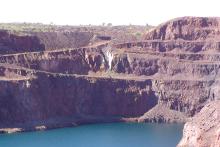Javelin Minerals has increased the JORC resource estimate for its Coogee gold-copper project near Kambalda in WA by 158 per cent to 3.65 million tonnes at 1.08g/t gold and 1.01 million tonnes at 0.41 per cent copper. The significant upgrade relates to a revised gold content of 126,685 ounces and was determined from an independent review of historic estimates, assumptions and drilling.


Javelin Minerals has increased the JORC resource estimate for its Coogee gold-copper project near Kambalda in Western Australia’s Goldfields region by 158 per cent to 3.65 million tonnes at 1.08 grams per tonne gold and 1.01 million tonnes at 0.41 per cent copper.
The company says the significant upgrade relates to a revised gold content of 126,685 ounces and was determined from an independent review of historic estimates, assumptions and drilling. Its total supergene and primary indicated resource is 963,242 tonnes at 1.31g/t gold for 40,562 ounces, while the complementary copper resource adds 4133 tonnes of the red metal.
Previous operator Ramelius Resources’ 2022 estimate for Coogee put the resource at 1.43 million tonnes at an average grade of 1.07g/t gold for 49,034 ounces, of which 614,000 tonnes at 1.43g/t gold for 28,252 ounces lay within the total indicated category for supergene and primary ores.
A key consideration in the upgrade from the previous 2022 mineral resource estimate includes an increase in the depth of the overall resource envelope, taking it from 90m below surface – the original open-pit resource limit – to now include gold and copper mineralisation down to 225m. It is a significant depth increase of 135m.
The new estimate also considers a jump in the assumed rate of recovery from the 96 per cent experienced during previous treatment of open-pit ores, to 96.4 per cent following metallurgical testwork by Javelin, which it says is consistent with processing figures from the previous owner’s open-pit operation in 2013.
Javelin Minerals executive chairman Brett Mitchell said: “This is a strong result which provides a solid platform on which to build a very substantial gold inventory on the doorstep of the world-class St Ives Goldfield. The scope for growth at Coogee is clearly immense. The mineralisation is open and we have numerous compelling targets.”
The company says gold mineralisation at Coogee extends along strike for 1.2km at an average width of 350m, extends to more than 225m vertically and exhibits strong potential to extend along strike to the north-west and also down-dip.
News of the upgrade comes hard on the heels of last week’s revelation that management had identified eight copper-gold exploration targets at its Coogee project after independent and collaborative reviews of reprocessed geophysical and other data. Of key significance in the present resource upgrade context is that initial interpretations of two of those targets point to a prevailing trend of north or north-westerly and down-dip extension gold mineralisation potential in the area immediately north of the old Coogee open pit.
The two recently-identified targets include a big untested magnetic anomaly just 300m north/north-east from the Coogee open pit, which Javelin believes could host gold-copper mineralisation. It is the company’s strongest anomaly in its Coogee mining lease and is its first-priority target.
The anomaly is modelled to lie at a depth of 175m below surface, directly below the main gold-copper mineralisation defined by previous reverse-circulation (RC) and diamond drilling. Management says the target has never been tested and could be a deep gold-copper mineralised zone.
Historic drilling within the Coogee mining lease area that also defined two magnetic mineralised copper-gold trends north and west of the Coogee deposit and currently remain open along strike and at depth, also support the modelling.
Javelin recently engaged independent geological consultancy OmniGeoX to compile, review and interpret all existing project drilling and geophysical data to help plan an exploration drilling program, with a view to making the earliest possible start on testing of priority targets.
The Coogee gold project tenements are on the north side of Lake Lefroy in WA’s Eastern Goldfields, about 20km north-east of Kambalda, which is among the State’s earliest nickel mining centres after the original deposit was discovered in 1954. The mine opened in 1967 and was operated by WMC Resources, which was taken over by BHP in 2005.
The project lies within a highly-fertile greenstone belt with multiple gold deposits and abundant gold occurrences nearby including Coogee, Salt Creek, Daisy-Milano and Lucky Bay, in addition to the major St Ives gold camp.
The Coogee gold deposit was discovered in the mid-1990s by Sovereign Resources and was mined by Ramelius in 2013 by an open pit about 70m deep, reporting 147,400 tonnes produced at 4.7g/t gold for 20,400 ounces of gold recovered. Ramelius treated its Coogee ore by conventional carbon-in-leach processing at the Burbanks Mill, south of Coolgardie, reporting 96.4 per cent metallurgical recovery.
Javelin believes there is the potential for a “big gold-copper system” that could lie at depth to the north-west.
That belief is further supported by company’s third priority geophysical target which lies about 750m west of the Coogee open pit and is also associated with a magnetic trend that is open to the north-west. The anomaly has not been followed up, despite the encouragement of a single drillhole put in by Ramelius that jagged 23m going 0.38g/t gold.
Javelin is now planning its next phase of extensional drilling to the west of the new resource envelope in a bid to increase the mineral resource estimate.
Is your ASX-listed company doing something interesting? Contact: matt.birney@businessnews.com.au












